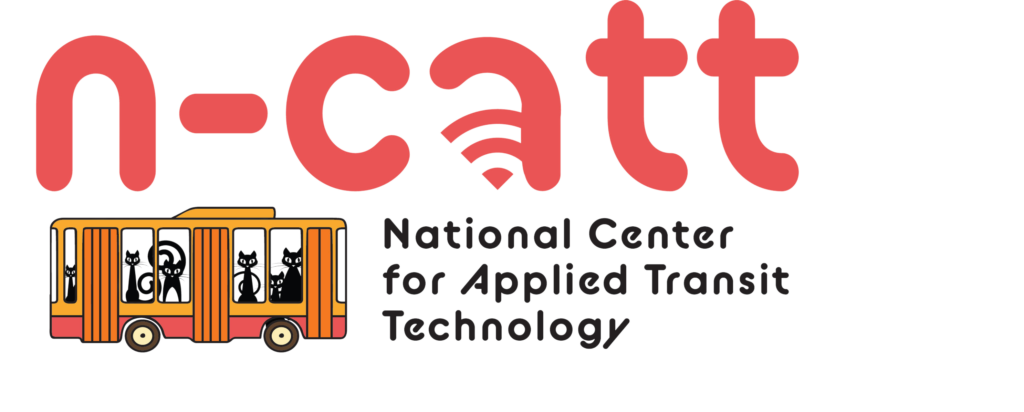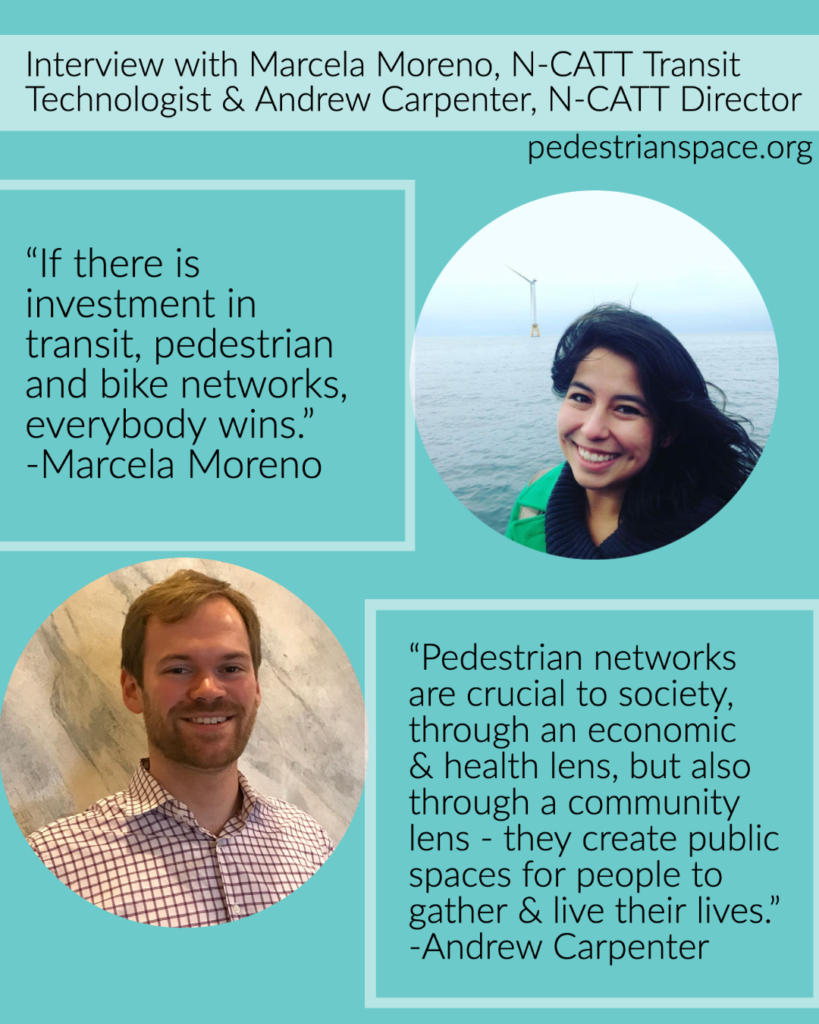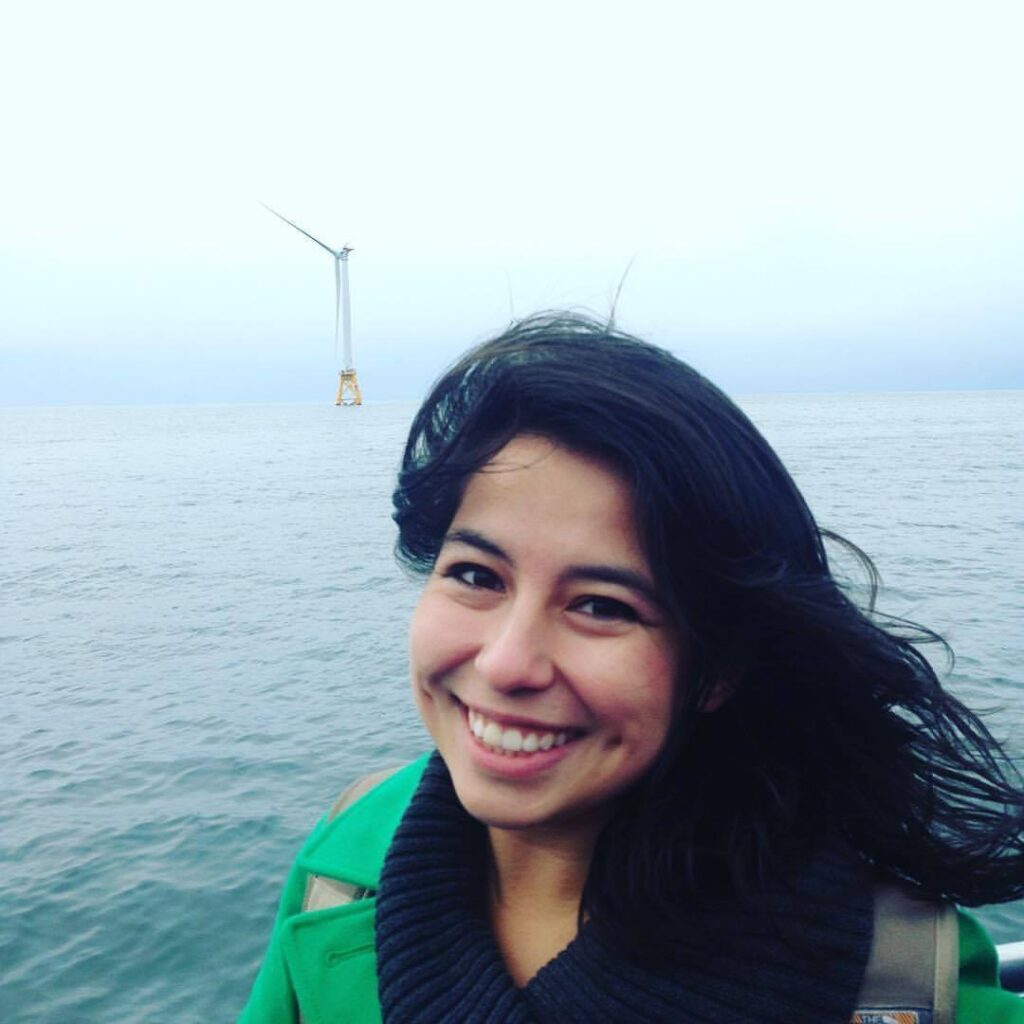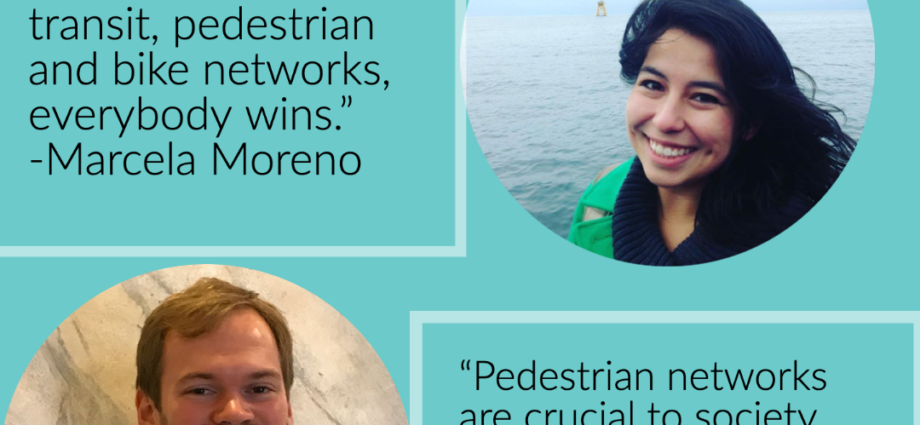“I think this is a critical time where we can invest in our public transportation providers to ensure these systems can bring their service up to where it needs to be. The pandemic has shown how important transit is to keeping our society moving.”
Marcela Moreno, Transit Technologist at N-Catt
N-CATT (The National Center for Applied Transit Technology) is a technical assistance center in the USA; funded through a cooperative agreement with the Federal Transit Administration (FTA). Their mission is to “…provide small-urban, rural, and tribal transit agencies with practical, replicable resources that help them apply technological solutions and innovations.”

Pedestrian Space had the opportunity to chat with Andrew Carpenter, Director at N-CATT, along with Marcela Moreno, Transit Technologist at N-CATT, about a range of issues including critical needs in modernizing communication to increase public transit ridership, enhancing pedestrian friendliness of transit systems, pandemic related drop in ridership, the importance and interrelated benefits of public transit and pedestrian networks and more.
“Pedestrian networks are crucial to society, through an economic and health lens, but also just through a community lens – they create public spaces for people to gather and live their lives.”
Andrew Carpenter, Director at N-Catt
Pedestrian Space: What were some of the most critical issues N-CATT observed that arose in 2020 amid the pandemic related to transit?
Andrew: At the beginning, there was a lot of uncertainty about what service was safe to provide, and communicating the frequent changes in service as transit agencies learned more about ridership patterns and safety related to the virus.
Marcela: I agree with Andrew. While I joined the N-CATT team in late 2020, the agency that I worked with struggled with adapting to quickly changing circumstances. While we were able to, the consequences included passengers being left behind, communication issues, and procurement issues for safety equipment.
Pedestrian Space: What are some of the most critical transit issues that N-CATT is observing with 2021 in mind?
Andrew: Being able to provide the same level of service as before the pandemic is a major uncertainty. Because transit relies so heavily on ridership to fund operations, the huge drop in ridership is creating major budget shortfalls. It will likely take years for ridership to return to pre-pandemic levels, which could cause transit agencies to cut service, which would then result in more people not returning to transit, and leading to a so-called “death spiral” of degrading service and dropping ridership/income. This is why transit agencies are calling for additional federal support. There of course are variations and outliers, but this is a significant concern. The people who are most affected by this situation are essential workers and low-income communities – the ones who most depend on transit, and who we most depend on to keep things running.
Marcela: What Andrew said! I think this is a critical time where we can invest in our public transportation providers to ensure these systems can bring their service up to where it needs to be. The pandemic has shown how important transit is to keeping our society moving.

Pedestrian Space: What are the specific transit challenges in small-urban, rural and tribal communities?
Andrew: Building on the last question, there’s also a lot of uncertainty about how to navigate social distancing while also serving everyone who needs a ride. Social distancing inherently limits capacity, but in areas without frequent service that means fewer people who need to get somewhere can do that. So what’s the balance of letting people onboard so they get somewhere while trying to spread out passengers as much as possible? Some agencies are beginning to use their automated passenger counters (APCs) to share vehicle crowding information with different apps, which would allow passengers to decide if they’re comfortable boarding at a certain crowd level, and choosing another option if not. Of course, that depends on the agency having enough APCs to share that information, passengers having the right apps to view it, and having options, but it’s part of a suite of tools to help. In general, it looks like places will begin reopening somewhat quickly, and there will be a lot to adapt to on the fly in the opposite direction of the rapid shutdowns of last year, and of course it’s easier to close service than open it, so that will be challenging.
Marcela: I’d also add that land use in small-urban and rural communities doesn’t necessarily make it easier to provide public transit. Sprawl and low-density land use makes transit planning a little bit more tricky. With micromobility and microtransit as potential solutions, planning staff at these smaller agencies may or may not be totally dedicated to transportation. Larger agencies have teams of planners and operations staff (and $$$) to explore and implement new technology – it’s a much harder lift for small-urban, rural, and tribal agencies.
“I think that if we take a public health-first approach on designing our transportation systems, active modes of transportation would take priority because they get us moving, but also because they are the most vulnerable on/near the road.”
MARCELA MORENO, TRANSIT TECHNOLOGIST AT N-CATT
Pedestrian Space: How can technology serve the essential flexibility that transit agencies need right now (especially in light of the pandemic) to quickly change operations and service?
Andrew: There are a few categories here. Data and planning tools can help planners identify the service priorities in areas that most need them; real-time information sources like automated vehicle location, passenger counters, and electronic fare payment systems can help monitor usage of fixed-route service and offer insights into where people are using the system, to allow agencies to adjust accordingly; some demand-response technologies will allow agencies to improve their service by offering more on-demand-style options than were previously possible; integrations with other options like bikeshare can help to fill gaps
Marcela: In my experience as a transit planner during the pandemic, having ridership data was paramount when we were faced with a driver shortage and needed to cut service. It was not an easy decision, but we were able to look at areas that were served by multiple routes or had low ridership. Having that data readily available and in a visualization helped us make our decision, and also share information with the public. Electronic fare payment systems, to Andrew’s point, allow agencies to collect more data, and even have more flexibility for how riders want to pay. I am extremely interested to see how micromobility options come back after the pandemic – recently, a study on Chicago’s Divvy bikeshare found that “during the pandemic, lower-income and BIPOC workers relied on bike share more than their wealthier, white counterparts.” (Better Bikeshare Partnership, 2021) I think, and I hope, that the pandemic provides context for policymakers, elected officials, and the public that public transportation (in its various formats) are a lifeline for essential workers. Through the pandemic, it was clear that frontline workers had to continue life, not even as usual, but as critical providers for the rest of us.
Pedestrian Space: How can modernizing communications and customer facing data systems encourage ridership in the post-corona world?
Andrew: Bringing information to passengers improves their perceptions of transit services, builds trust, and helps people realize what they can access. For trip-planning purposes, it helps people better manage their time and understand their options before starting their trip. For community engagement, it opens multiple pathways for people to participate. This is, of course, only part of the puzzle, and public agencies need to be highly proactive in meeting people where they are, and collaborating with communities when possible.
“There should be a big focus on expanding internet access – cellular or broadband – to everyone in the US.”
ANDREW CARPENTER, DIRECTOR AT N-CATT
Pedestrian Space: What regions or communities are you seeing as in the most critical need of this modernizing element?
Andrew: There should be a big focus on expanding internet access – cellular or broadband – to everyone in the US. This would help unlock access to a lot of the previously mentioned things.
Marcela: I will echo the broadband need. The broadband access piece touches on so many aspects beyond transportation. I think this is a nationwide issue in small-urban, rural and tribal communities that the COVID-19 pandemic has highlighted, especially when students were moved from in-person to virtual education.
Pedestrian Space: What communities serve as a type of role model in this sense- as already embodying a modernized communications system that serves its transit system and ridership well?
Andrew: We actually have a guidebook coming out about this! That includes a few examples, but some that come to mind as well: Denver RTD (though they’re a large organization with much more staff capacity);
Marcela: I think there are examples all over the country – Chatham Area Transit System in Savannah, GA recently started utilizing text messages for service alerts. Roaring Fork Transportation Authority in Colorado is partnering with a bikeshare non-profit to complement their BRT route. At RFTA, you can use the Transit App to plan a multimodal trip, and even book your bikeshare reservation. We have a podcast that highlights some of the neat things that small-urban, rural and tribal transit agencies are doing with innovations in technology.
“Every transit user is a pedestrian (perhaps cyclist) at some point in their trip. So making access points to transit systems pedestrian-friendly is critical. In my mind, this would mean creating a highly walkable zone at least a mile out from a transit route. That’s ambitious, of course.”
ANDREW CARPENTER, DIRECTOR AT N-CATT
Pedestrian Space: As we focus on pedestrian issues, of course we would like to have your insight on issues of walkability and pedestrianization in small-urban, rural and tribal communities. What are some of the critical issues in terms of pedestrian safety, access and walkability in these communities?
Andrew: Every transit user is a pedestrian (perhaps cyclist) at some point in their trip. So making access points to transit systems pedestrian-friendly is critical. In my mind, this would mean creating a highly walkable zone at least a mile out from a transit route. That’s ambitious, of course.
Marcela: Agreed. I grew up in the southern United States, and many places are so auto-dependent at the cost of pedestrian safety. The presence of ADA-accessible sidewalks, and having a complete network of them is key. When co-located with transit routes, it allows people to have an ecosystem of choice. Honestly, I think that if we take a public health-first approach on designing our transportation systems, active modes of transportation would take priority because they get us moving, but also because they are the most vulnerable on/near the road.
“If there is investment in transit, pedestrian and bike networks, everybody wins.”
MARCELA MORENO, TRANSIT TECHNOLOGIST AT N-CATT
Pedestrian Space: How do you view the benefit of pedestrian networks, safety and access for public transit?
Andrew: Pedestrian networks are crucial to society, through an economic and health lens, but also just through a community lens – they create public spaces for people to gather and live their lives.
Marcela: I touched on it a little bit before, but I think that the benefit is immense. From the public health benefit of prioritizing these active modes of transportation that ultimately complement public transit use, to racial, disability & economic justice of putting these more accessible modes of transportation at the forefront of planning. You’ll often hear that car ownership is expensive – but it is also not something everyone can do. If there is investment in transit, pedestrian and bike networks, everybody wins.

Marcela Moreno, Transit Technologist at N-CATT

Andrew Carpenter, Director at N-CATT

